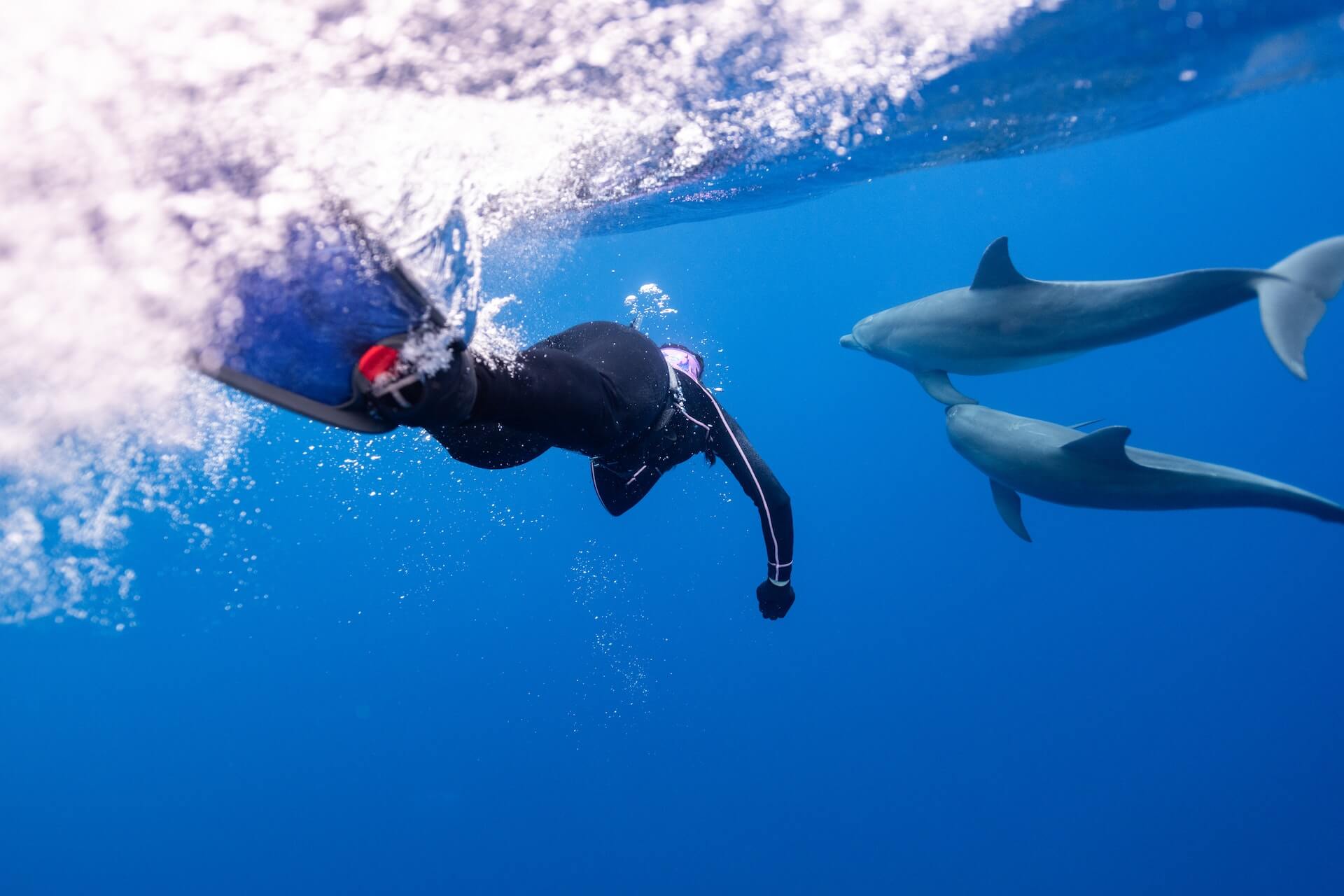Dolphins, with their undeniable intelligence and playful demeanor, have fascinated humans for centuries. Their frequent interactions with humans, whether they are riding the bow wave of a ship or curiously investigating a swimmer, often spark curiosity and ignite a desire to understand these incredible creatures better.

In this article, we will answer the most common questions people have regarding swimming with dolphins, such as why dolphins might choose to swim close to humans, how safe it is to swim with them in the wild, the precautions one should take when in close proximity, and more.
By understanding these intelligent marine mammals better, we can ensure our interactions with them are respectful, safe, and positive for both sides.
Why do dolphins swim close to humans?
Dolphins are known to be quite social and curious creatures. They may swim close to humans due to curiosity, to play, or even to seek help in some cases. For example, they might approach humans to get rid of a hook, net, or other harmful material entangled in their body.
Sometimes, dolphins might also approach boats for the fun of riding bow and stern waves. However, understand that each interaction can depend on the individual dolphin’s temperament and past experiences with humans. Not all dolphin and human interactions have been positive, and usually it is the dolphin that ends up suffering.
Is it safe to swim with dolphins in the wild?
While it can be an extraordinary experience, swimming with dolphins in the wild can carry risks both for humans and dolphins. Dolphins are wild animals and their behavior can be unpredictable. They are powerful swimmers and could unintentionally harm a human.
For the dolphins, close contact with humans can expose them to disease, cause them stress, and potentially interfere with their natural behavior and habitat. Therefore, it’s recommended to observe these animals from a distance rather than attempting to swim with them.
What precautions should I take when dolphins are near?
Firstly, maintain a respectful distance and don’t attempt to touch or feed them. Feeding can make them reliant on human food, which can be harmful to their health and change their natural behavior.
If you’re in a boat, try to avoid sudden changes in speed or direction that could potentially frighten or harm the dolphins. It’s also important not to discard any litter into the water, as it could endanger marine life. Always follow local regulations regarding interactions with dolphins.
Do dolphins communicate with humans?
Dolphins are very intelligent animals with complex communication systems amongst themselves. They use a range of clicks, whistles, and body movements to communicate.
While there have been many studies and attempts to facilitate communication between dolphins and humans, there’s currently no evidence to suggest that dolphins can understand complex human language or communicate in a way that humans can fully understand.
However, dolphins have been trained to understand and respond to simple human commands in controlled environments, such as marine parks.
How do I interact safely and respectfully with dolphins?
Remember that dolphins are wild animals and you must respect their space and natural behaviors. Avoid chasing, touching, or feeding dolphins. If you’re in the water with dolphins, let them approach you rather than swimming towards them.
Maintain a quiet and calm demeanor to avoid startling them. Follow the “look but don’t touch” principle and always adhere to local guidelines for marine life interaction, which usually involves keeping your distance and only observing.
Is it legal to touch dolphins when they approach you?
The legality of touching dolphins can vary depending on the jurisdiction. In many places, such as in the United States under the Marine Mammal Protection Act, it’s illegal to harass, feed, hunt, capture, or kill any marine mammals, including dolphins.
Harassment includes any act of pursuit or annoyance that has the potential to disturb the animals by causing disruption of behavioral patterns, which could include touching. Basically, keep your hands to yourself.
Can I swim with dolphins without disturbing them?
While it’s possible to be in the water with dolphins without causing them apparent immediate distress, remember that we may not fully understand the impact of such interactions on these animals.
Sudden movements, attempts to touch or chase the dolphins, or getting too close could cause them stress. Disturbances could potentially alter their natural behaviors, disrupt their feeding or resting, and cause unnecessary tension. It’s recommended to enjoy observing dolphins from a safe and respectful distance.
Do certain species of dolphins behave differently around humans?
Yes, behavior around humans can vary between different species of dolphins and even between different populations of the same species. Factors such as their past experiences with humans, their habitat, and their individual personalities can all play a part in how they react to human presence.
Some species or groups may be more curious and approach humans more often, while others may be more cautious or reserved. Since it is impossible to predict how a wild animal such as a dolphin might react, it is best to keep your distance.
How should I respond if a dolphin seems aggressive?
If a dolphin shows signs of aggression such as charging, hitting with their tail, or showing their teeth, calmly but swiftly distance yourself from the animal. Avoid direct eye contact, sudden movements, and turning your back on the dolphin, as these can be interpreted as aggressive behaviors.
If you’re in the water, try to exit without causing a splash or commotion. Remember, you must respect their space and avoid actions that may provoke an aggressive response. Try your best to stay calm, because if you panic and flail around, you are likely to aggravate the dolphin further.
Sources:

